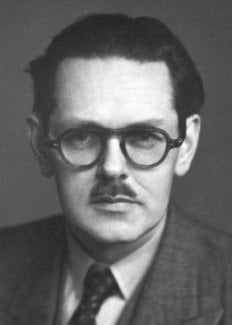Archer J.P. Martin
Biographical

Archer John Porter Martin was born on March 1st, 1910, in London where his father was a general medical practitioner. He attended Bedford School from 1921 to 1929 when he entered Cambridge University to graduate in 1932. After a year in the Physical Chemistry Laboratory he obtained a post at the Dunn Nutritional Laboratory, where he worked under L.J. Harris and Sir Charles Martin, and in 1938 he moved to the Wool Industries Research Association at Leeds. From 1946 to 1948 he was Head of the Biochemistry Division of the Research Department of Boots Pure Drug Company at Nottingham and in 1948 he joined the staff of the Medical Research Council, first at the Lister Institute and later at the National Institute for Medical Research. He was appointed Head of the Division of Physical Chemistry at the Institute in 1952 and he was Chemical Consultant from 1956 to 1959. Since 1959 he has been a Director of Abbotsbury Laboratories Ltd.
Martin entered Cambridge University with the intention of becoming a chemical engineer but, due to the influence of Professor J.B.S. Haldane, then Reader of Biochemistry at Cambridge, he eventually specialized in biochemistry. His first researches, as an undergraduate, resulted in a method of detecting pyro-electricity by observing the attraction of a metal plate for crystals that had been immersed in liquid air. At Cambridge he worked on ultraviolet adsorption spectra and at the Nutritional Laboratory he was concerned with the attempted isolation of Vitamin E and in the pathological effects of prolonged Vitamin E deficiencies. In these latter studies he used solvent extraction and chromatographic methods which were to lay the foundation for his later work on chromatography. He also worked, along with others, on the B2 group of vitamin deficiencies in pigs.
At the Wool Industries Research Association he worked on the felting of wool, first with R.L.M. Synge and later with Consden and Gordon, and on amino-acid analysis. It was here that he developed his method of partition chromatography; more recently, with A.T. James, he has developed the method of gas-liquid chromatography.
Dr. Martin, a Fellow of the Royal Society (1950), was made Companion of the British Empire in 1960. He received the Berzelius Medal of the Swedish Medical Society (1951), the John Scott Award (1958), the John Price Wetherill Medal (1959), the Franklin Institute Medal (1959), and the Leverhulme Medal (1963).
In 1963, he was appointed to deliver special lectures (as “buitengewoon hoogleraar”) at the Technological University of Eindhoven, The Netherlands.
In 1943 he married Judith Bagenal; they have one son and three daughters.
This autobiography/biography was written at the time of the award and first published in the book series Les Prix Nobel. It was later edited and republished in Nobel Lectures. To cite this document, always state the source as shown above.
Archer J.P. Martin died on July 28, 2002.
Nobel Prizes and laureates
See them all presented here.
